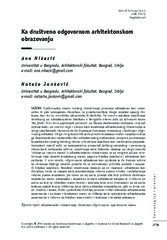Prikaz osnovnih podataka o dokumentu
Towards socially responsible architectural education
Ka društveno odgovornom arhitektonskom obrazovanju
| dc.creator | Nikezić, Ana | |
| dc.creator | Janković, Nataša | |
| dc.date.accessioned | 2019-10-31T11:19:43Z | |
| dc.date.available | 2019-10-31T11:19:43Z | |
| dc.date.issued | 2014 | |
| dc.identifier.issn | 1846-5226 | |
| dc.identifier.uri | https://raf.arh.bg.ac.rs/handle/123456789/151 | |
| dc.description.abstract | In higher education architecture is traditionally considered either an artistic or an engineering discipline, while its other aspects (sociological, economic or ecological) are overlooked or neglected. Based on the results of the research carried out at the Faculty of Architecture in Belgrade (Master of Architecture programme) during the elective course “Re-Birth: New life of abandoned spaces“, this article examines how, shifting from a strict academic framework, architectural education can contribute to the formation of expert, versatile and socially responsible architects. The idea of the course was to position a specific place and its community within the structure of architectural mechanism, rather than look at it in a merely physical context where the community is an obstacle and a burden. When we sum up the working method and the interpretative potential of the subject through students’ works, the research discussion points to the value of the “learning based on the place“method in architectural education and possible ways of strengthening the connections between the place, the local community and architecture. The role of architecture is to open up space for dialogue which will help improve the heritage and advance the local community. Three facts emerge from the research. Firstly, the role of architecture can change by redefining its attitude to man and place and thus encouraging the social interaction. Secondly, the characteristics of architecture should change according to the purpose and significance of a particular place - the cultural landscape is shaped in such a way that the most striking components of architectural intervention are sound, smell, touch, light and shade, the psychological experience of space. And finally, architectural intervention should optimally shape a concrete place with regard to its population and cultural and historical references. | en |
| dc.publisher | INST SOCIAL RES ZAGREB | |
| dc.rights | openAccess | |
| dc.source | Sociologija i Prostor | |
| dc.subject | Architectural education | en |
| dc.subject | Social responsibility | en |
| dc.subject | Specific characteristics of a place | en |
| dc.title | Towards socially responsible architectural education | en |
| dc.title | Ka društveno odgovornom arhitektonskom obrazovanju | sr |
| dc.type | article | |
| dc.rights.license | ARR | |
| dcterms.abstract | Јанковић, Наташа; Никезић, Aна; Ка друштвено одговорном архитектонском образовању; Ка друштвено одговорном архитектонском образовању; | |
| dc.citation.volume | 52 | |
| dc.citation.issue | 3 | |
| dc.citation.spage | 279 | |
| dc.citation.epage | 292 | |
| dc.citation.other | 52(3): 279-292 | |
| dc.citation.rank | M220 | |
| dc.identifier.doi | 10.5673/sip.52.3.3 | |
| dc.identifier.scopus | 2-s2.0-84919820047 | |
| dc.identifier.fulltext | https://raf.arh.bg.ac.rs//bitstream/id/35/149.pdf | |
| dc.type.version | publishedVersion |

